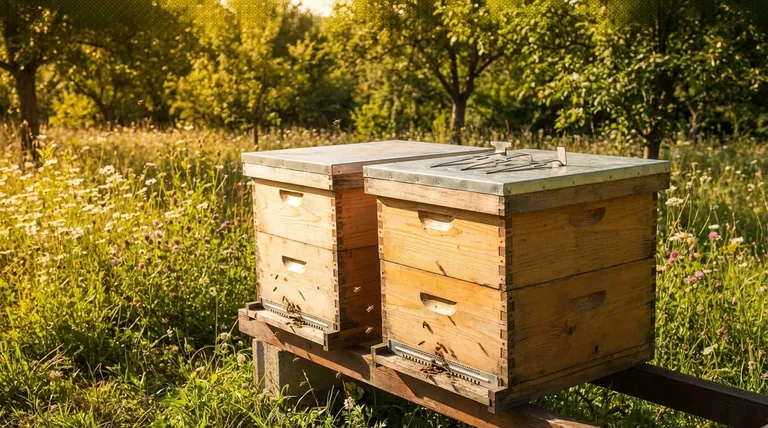The recommended number of hives for a new beekeeper is two. This approach provides the best balance between a manageable workload and a strategic advantage for learning. Starting with two colonies dramatically increases your chances of successfully overwintering at least one hive in your critical first year.
The core principle is not about doubling your honey, but about creating an insurance policy. With two hives, you can compare colony health and use resources from the stronger hive to support the weaker one, a crucial technique unavailable to single-hive beekeepers.

The Strategic Advantage of Starting with Two
Starting with a single hive can feel like a cautious first step, but it's actually the riskier path. The "two-hive" method is a time-tested strategy that directly addresses the most common challenges a new beekeeper will face.
The Power of Comparison
With two hives side-by-side, you gain an invaluable learning tool. You have a built-in control group for comparison.
Is one hive lethargic while the other is buzzing with activity? This contrast immediately alerts you to a potential problem, prompting an investigation into issues like queen failure, disease, or pests.
A single hive gives you no frame of reference. You won't know if what you're observing is normal, exceptional, or a sign of impending collapse.
A Built-in Insurance Policy
Bee colonies, especially new ones, can fail for many reasons. Losing your only hive in the first season is a common and deeply discouraging experience that causes many people to quit.
Having a second hive acts as insurance. If one colony dies, you are not forced to start over from scratch. You still have bees, you can learn from the failure, and you can continue your beekeeping journey into the next year.
The Ability to Share Resources
This is the most powerful benefit of the two-hive system. A strong colony can be used to directly save a weaker one.
If one hive loses its queen, you can transfer a frame of eggs from the strong hive to allow the weak one to raise a new queen. If one hive is low on population, a frame of capped brood from the healthier hive can provide a critical boost. These manipulations are fundamental to sustainable beekeeping and are impossible with only one hive.
Understanding the Trade-offs
While two is the standard recommendation, it's essential to understand the reasoning behind avoiding one hive or, conversely, starting with too many.
The High Risk of a Single Hive
Yes, you can start with only one hive, but you must recognize the risk. You lose all the comparative and resource-sharing benefits.
Your success becomes entirely dependent on that single colony thriving and your ability to diagnose problems without a reference point. If you choose this path, it is critical to have a local mentor you can rely on for advice and potential resources.
The Danger of Starting with Too Many
If two is good, more is not necessarily better for a beginner. Starting with three or more hives can quickly lead to overwhelm.
The initial equipment cost rises significantly, and the time commitment for inspections multiplies. A new beekeeper can become so bogged down in basic management that they fail to learn the subtle details, leading to mistakes across all their hives. A manageable start of two allows you to grow to three or four strong hives the following year.
Making the Right Choice for Your First Year
Your approach should be based on your primary goal. The initial investment in a second hive pays dividends in education and resilience.
- If your primary focus is maximizing your chance of success: Start with two hives. This is the undisputed best practice for learning effectively and ensuring you have bees in your second year.
- If your primary focus is minimizing initial cost: You can start with one, but you must accept the higher risk of failure and proactively find an experienced local mentor for support.
Starting with the right number of hives sets the foundation for a successful and rewarding beekeeping journey.
Summary Table:
| Number of Hives | Key Advantage | Key Risk |
|---|---|---|
| 1 Hive | Lower initial cost | High risk of failure; no reference point for learning |
| 2 Hives (Recommended) | Built-in insurance; ability to share resources; comparative learning | Slightly higher initial cost and time commitment |
| 3+ Hives | Potential for higher honey yield | High risk of overwhelm for a beginner; steep learning curve |
Ready to start your beekeeping journey with the right equipment?
HONESTBEE supplies durable, high-quality beekeeping supplies and equipment to commercial apiaries and distributors through our wholesale-focused operations. We provide the reliable foundation you need for a successful start with your first two hives.
Contact HONESTBEE today for wholesale pricing and expert support!
Visual Guide

Related Products
- HONESTBEE Advanced Ergonomic Stainless Steel Hive Tool for Beekeeping
- HONESTBEE Professional Long Handled Hive Tool with Precision Cutting Blade
- Professional Dual-End Stainless Steel Hive Tool for Beekeeping
- Wholesales Dadant Size Wooden Bee Hives for Beekeeping
- Stainless Steel J Hook Hive Tool for Beekeeping
People Also Ask
- How should beekeepers handle bees when using a hive tool? Master Calm, Deliberate Techniques
- Why do hive tools have a hole? Unlock the Secret to Efficient Beekeeping
- What are some common uses of a hive tool? Essential Multi-Purpose Tool for Every Beekeeper
- What is the hole in a hive tool for? A Multi-Tool for Apiary Repairs and Maintenance
- What are the features of a regular hive tool? The Essential Multi-Tool for Every Beekeeper



















